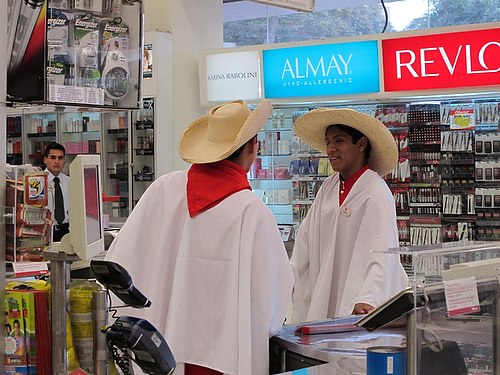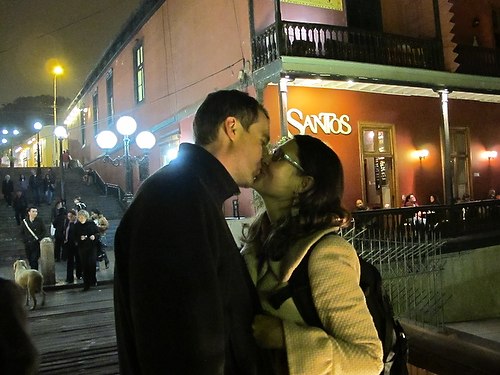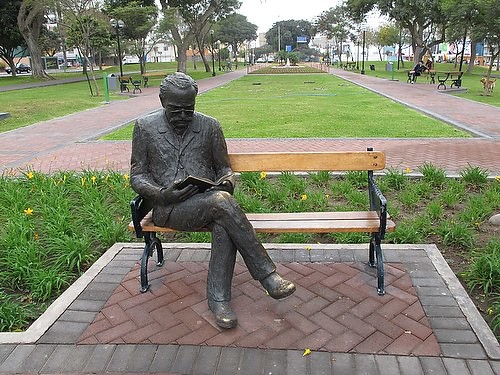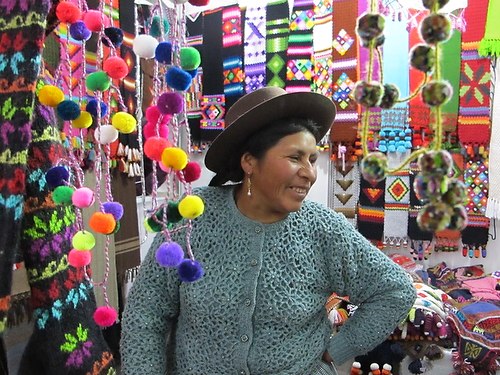LIMA, Peru – I landed in this misty Andean capital a week ago for the wedding of my dear friend and former student, Sara Fajardo. Eight years ago I had come here with her and spent a month divided between here in Lima and in Ayacucho, where we translated for a medical mission and then did interviews with local members of the Truth and Reconciliation Commission.
The omnipresent grey mist cast a watercolor wash over the city, dampening its vibrancy, but not for long. Peru’s particular essence began to come back to me as we drove along the coast between towering cliffs and crashing waves toward the sparkling enclave of Miraflores. The cliffs were carved by the ages but soon I saw something different: They had apparently been carved a good bit more recently by bulldozers. I was shocked at the absolute dearth of greenery as we entered the seaside drive – the cliffs on the left had been stripped of the lush vegetation I had remembered, and dust was everywhere. A huge seaside construction project was going on – President Alan Garcia’s new “Costa Verde” – a project that promises “a better Lima for all” when it’s finally finished – “but that will be for my grandchildren, not for me, at the rate they’re going,” said my gravel-voiced taxista, Oscar, with a chuckle.

“Why don’t they plant something to stabilize the hillsides?” I asked, dismayed, looking out at the tide of topsoil visible all down the coast and thinking of all the erosion protection measures available in the north. “They will – they’re not finished,” the taxi driver explained. “It doesn’t rain here, so everything has to be irrigated.”
This was something I’d forgotten about Lima – which is easy to do in other parts of the city, lush as it is with palm-lined corridors, parks and gardens. The Peruvian coast, I had read, is one of the driest places on earth, as it lies in a double rain shadow – the Andes block rain from the east, and a strong coastal air current blocks rain from the west, leaving the coast with less than 2 inches of rain a year, most of that from the grey fog that covers us now.
And indeed, as I read about the Costa Verde project, it does seem it will add a marvelous new dimension to an already marvelous city, with a landscaped public space along the seafront and 17 pedestrian bridges granting access to the beach.
In the meantime, however, my eyes were relieved to see the green cliffs of historic Barranco in the distance – some things, at least, hadn’t changed. And as we made our way up into Miraflores, signs of progress were everywhere; bulldozers were paving the way for a new cobblestone entry, new buildings were under construction and the city hummed with life. The comparison with El Salvador was inevitable; suddenly I felt myself to be in a developed country. Remembering, of course, that I was seeing the Manhattan of Peru – the crazily tilting wooden shacks, stacked like dominoes on the hillsides outside of town, were a quick reminder that Miraflores does not equal Peru.
One of the first things I noticed was the cold – much colder than I had remembered, with highs hovering around the low 60s and temperatures dipping into the 40s at night. It’s winter, so I expected a chill, but I arrived just in time for a cold wave, and my host, Angelo Gandullia (of Hostal Tradiciones, an unparalleled host, by the way, and a speaker of many languages who goes to great lengths to orient his guests, helping them enjoy the best of Lima and organize trips all over the country) tells me it’s the coldest spell they’ve had in three decades – “climate change,” he says, again that word that seems to be on everyone’s lips here in the global south. The summers have been hotter than usual, he tells me, with the glaciers that supply water to the cities drying up, a trend that worries him, given that it’s the city’s only source of water. To him, the freakish cold spell falls into the same category.
Regardless of the causes, it’s a definite climate change for me, coming as I have from the tropics, and it didn’t take long for my body to succumb. I fell ill with a fever and cough my first night, and it was as I tossed and turned and sweated that I remembered a similar night eight years ago in the highlands of Ayacucho, where I developed a case of pneumonia. Determined to avoid such a scenario and to enjoy the wedding, I headed off the next morning to visit with a pharmacist, who prescribed an antibiotic that knocked that gathering storm right out of my chest. (Angelo recommended InkaPharma for the best prices and quality).
Miraflores was even more spectacular than I’d remembered, with its cafes and boutiques and plazas and the sparkling Larcomar commercial center on the cliffs overlooking the sea. I soon made my way to the lively and colorful Indian Market to pick out an alpaca poncho, which I needed to winterize my wardrobe. We had dinner one night in the restaurant on the archaeological site of Huaca Pucllana, the pyramids an illuminated backdrop against the night sky, with the modernity of skyscrapers in the distance.
We ended the evening in beautiful historic Barranco, a neighborhood adjoining Miraflores, where the central plaza lights up at night to show off its colonial charm.
“I need you to kiss me on the Puente de Suspiros,” the bride advised the groom, and we made our way to the historic “Bridge of Sighs” that looks out over gardened plazas, lively cafes and bars and in the distance, the ocean. It may well be the most romantic spot in all of Latin America.

We shopped in a special artisan market set up for the fiestas patrias, enjoyed pisco sours and sweet humitas, a type of tamales that come in all flavors, for dessert.
Here are a few images from our outings in Miraflores, including a visit to the supermarket, where staff uniforms included the traditional poncho, and a nighttime view of the Huaca Pucllana ruins, where we had a memorable dinner at the elegant onsite restaurant.
Created with Admarket’s flickrSLiDR.
And here’s the lovely artsy, historic neighborhood of Barranco, with Sara and Ted sealing their fate on the classic Puente de Suspiros. The artisans pictured here crafted my neices’ and daughter’s birthday gifts. And the last set is an exhibition in Barranco’s Central Plaza of traditional masks from all the Peruvian countryside.
Created with Admarket’s flickrSLiDR.


Leave a Reply